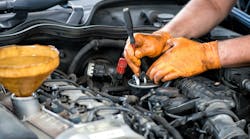Editor’s note: This is the third part of a series looking at maintenance decisions. Read part one and part two here.
Travis Wynes, director of fleet services at Fleet Advantage, an asset management and business intelligence firm, said it is important to look at the whole picture before deciding whether to handle maintenance in-house or outsource.
“The age of equipment, utilization and downtime, and vendor options have to be considered,” Wynes said. “Another part of the decision is technician recruitment needs. Maintenance deteriorates without them. It shows in equipment, in more breakdowns, roadside inspection issues, driver retention, missed deliveries and lower customer satisfaction. In some cases, internal fixes can be more difficult, costly and time consuming, and a vendor with the right capabilities can resolve some of those issues.”
Fleet Advantage spells out how effective use of data can reduce maintenance and repair costs in a report on Maintenance & Repair (M&R) Trends.
Maintenance and repair costs are at the forefront as one of the highest variable and volatile costs of a fleet’s operation. A benchmarking survey directed at fleet executives last year indicated that 40% of participants listed maintenance and repair as the largest motivators for truck replacement other than fuel economy, up from 26% in 2015.
The report provides various M&R data comparisons, helpful tips to lower costs and illustrates the impact M&R and vehicle age have on the costs of operating a Class 8 fleet.
M&R costs vary from truck to truck, but history shows there are specific areas where M&R becomes particularly costly, especially in trucks that are approaching 300,000 miles. That includes the failure of engine components and brakes, which lead to significantly higher costs after about 250,000 miles.
Lowering the average age of a fleet is vital to decreasing costs, Wynes said. Long-term vehicle ownership means an organization has more variable and unpredictable costs to manage, including M&R. Conversely, a shorter lifecycle may equate to a slight increase in the initial fixed cost of acquiring a vehicle, but it is still less expensive over time.
The industry’s changing mindset and shift toward more fuel-efficient trucks requires replacing vehicles more frequently, which impacts overall M&R costs, Fleet Advantage said. Fleet achieve savings by replacing current equipment with newer models, which essentially resets per-mile maintenance costs.
The average per-mile M&R cost (including tires) when operating trucks over a four-year period is 6.18 cents per mile, compared with 10.48 cents per mile when operating trucks over a seven-year period.
The lifecycle excess variable cost equates to $34,379 per truck over the course of seven years. Fleets operating newer equipment are also benefitting from continuous warranty coverage.



